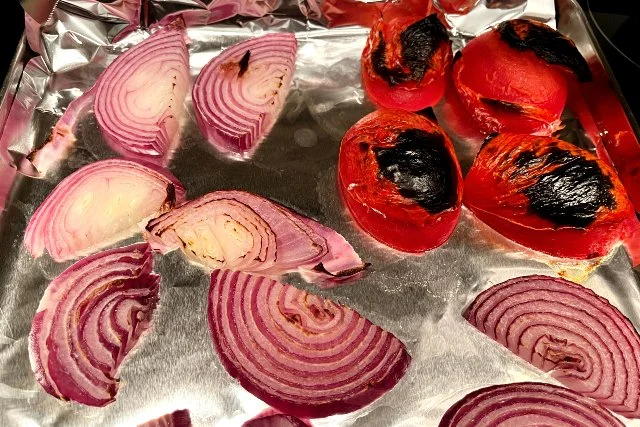Elusive Spicy Mexican Orange Sauce Adventure
One of our favorite taco trucks in the South Bay didn’t invent spicy, creamy, addictive orange-colored sauce, but theirs was the first we ever remember wanting to eat again as soon as humanly possible.
While enjoying a leftover loaded quesadilla the next day for a solo lunch, I shotgunned the extra sauce directly from the container. No regrets.
After following the truck to its new location, though, we noticed a sad handwritten note in the window: “No orange sauce today.” The sign stayed up.
Guillaume later learned that they only offer the delicious sauce with catering service now. Truck patrons are out of luck. Another local food truck makes a decent orange sauce, but not as good as the elusive one, and it’s also occasionally unavailable.
Clearly I had to make some myself. Serendipitously, my friend Cami is a hot sauce aficionado and steered me toward a successful sauce she made from a recipe originating with the Bay Area chain Tacolicious.
The ingredient list is delightfully short. Yet, for what seems like a simple recipe, online commenters recounted numerous pitfalls: burned chiles, overpowering vinegar, face-melting spice levels, way too much salt.
From General Tso’s tofu adventure, I knew that it would be deeply unwise to pack dried árbol chiles — and all their seeds — into a ½ cup measure for this sauce. And what does a half cup of dried chiles even mean?
I forged ahead, determined to answer my burning questions along the way, fill in obvious gaps, and incorporate sensible tweaks from Cami and commenters who backed up their adjustments with impressive photos.
Yes, I nearly set off our smoke alarms. Yes, I nearly tossed out an essential flavor element before catching myself. And yes, the resulting orange sauce was incredibly tasty to the point where we licked our spoons. It’s not the exact same one we’d been chasing, but whooo boy was it close.
Tasty Mexican Orange Sauce
Adapted from an original Tacolicious recipe
Makes around 1 quart
2 large red plum or Roma tomatoes
1 red onion, approx. 12 oz.
8g (0.3 oz.) dried whole árbol chiles (approx. 18, but go by weight)
2 dried whole guajillo peppers
3 medium garlic cloves
1 C. vegetable oil plus 2 Tbsp. for frying
⅓ C. apple cider vinegar
Water
Salt
Equipment: Small skillet, blender, tongs, baking sheet, food-prep gloves, sharp knife.
Put on food-safe gloves and measure out the chiles.
Guajillo peppers: Remove the stem and then slice each pepper along its side to open up and take out the seeds. Chop the seeded peppers into large chunks and put them in a small glass mixing bowl.
For the árbol chiles: Remove the stems from each chile. Break the chile in half and gently shake out the seeds to dislodge them. Might need to break into more pieces. Add the pepper exteriors to the mixing bowl. (I left in the seeds for one — one! — árbol chile plus maybe a few extra seeds got stuck in there. The resulting spice level for this sauce was consistently medium-hot.)
Boil approximately 2 cups of water. Pour at least 1 cup into the mixing bowl with the chiles and let them soften for about 15 minutes.
Trim, peel, and cut the onion half into thick slices. Remove the tomato stems and then cut each one in half lengthwise.
Place the oven rack fairly close to the broiler. Line a baking sheet with foil. Arrange tomatoes cut side down on the sheet in one section and onion slices on the other. Turn on a kitchen or whole-house fan, if possible.
Keeping an eye on them, broil for about 7 minutes or until the onions and tomatoes have become soft and slightly charred. The tomato skins on mine got seriously charred to the point where they were smoking. That’s okay. This is flavor.
Remove the baking sheet from the oven and set aside to cool.
Peel and trim the garlic cloves. Cut each one in half and remove the germs, if desired. Add 2 tablespoons vegetable oil to a small nonstick skillet or frying pan. Set over medium heat. Add the garlic. Once sizzling, turn fairly regularly to brown them on all sides, about 3 minutes.
Pour the browned garlic and garlicky oil into the blender base. Add the broiled onion slices and tomatoes, including any charred skins, to the blender. Pour in ⅓ cup apple cider vinegar. Add ½ tsp. salt.
Drain the softened chiles through a strainer into a measuring cup. Add the strained chiles to the blender.
Measure out ½ cup of the chile soaking liquid and add to the blender.
Cover and blend on high until smooth. Carefully remove the stopper in the center of the blender lid.
Put a cup of vegetable oil into a glass measure with a spout.
With the blender on its lowest speed, slowly pour the vegetable oil in through the lid hole, allowing it to emulsify. Stop the blender, taste the sauce, and then blend in more salt until it’s at your preferred seasoning level. I ended up adding another ½ teaspoon plus a few extra shakes.
This sauce will keep well in the fridge for several weeks. If you notice separation, make sure the lid is on tightly and shake the jar vigorously for a few seconds to re-emulsify.
Tip: For nachos and other melty dishes, spoon cold sauce on top to serve. Heating this sauce makes it prone to separation.


